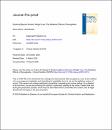Exploring Beyond Numeric Weight Loss: The Metabolic Effects of Semaglutide.

View/
Publisher version (Check access options)
Check access options
Date
2025-03-17Metadata
Show full item recordAbstract
The global burden of overweight and obesity has increased by threefold since the 1970s, which led to increased incidences of cardiovascular disease and type 2 diabetes. This review aimed to explore the metabolic impacts of semaglutide, including its effects on hunger and satiety, weight loss maintenance and regain, body composition, lipid profile, and glycemic control. Studies have shown that semaglutide reduced fat mass, particularly visceral fat, while preserving lean muscle mass, as the proportion relative to total body mass decreased by 3.5% and 2.0% for total and visceral fat mass, respectively, while it increased by 3.0% for lean body mass. Also, it enhanced glycemic control, as evidenced by significant reductions in hemoglobin A1C (HbA1c) with the 0.5 mg and 1.0 mg doses. From a baseline range of 8.1–8.7%, 0.5mg dose lowered HbA1c by 1.2–1.5%, while the 1.0 mg dose reduced it by 1.4–1.8%. Furthermore, semaglutide was the only effective Glucagon Like Peptide-1 Receptor Agonist in reducing Low-Density Lipoprotein and total cholesterol levels, with mean differences of -0.16 mmol/L and -0.48 mmol/L, respectively. Evidence shows that withdrawing semaglutide led to weight regain, while continued treatment resulted in further weight loss. Semaglutide also slowed weight regain and promoted weight loss after failed bariatric surgery. It also significantly reduced ad libitum energy intake, decreased hunger, and increased satiety in multiple trials. Overall, these findings underscore the potential of semaglutide as a comprehensive treatment for obesity and type 2 diabetes.
Collections
- Human Nutrition [421 items ]


